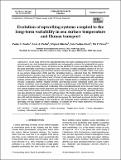Por favor, use este identificador para citar o enlazar a este item:
http://hdl.handle.net/10261/39259COMPARTIR / EXPORTAR:
 SHARE SHARE
 CORE
BASE CORE
BASE
|
|
| Visualizar otros formatos: MARC | Dublin Core | RDF | ORE | MODS | METS | DIDL | DATACITE | |

| Título: | Evolution of upwelling systems coupled to the long-term variability in sea surface temperature and Ekman transport |
Autor: | Pardo, Paula C. CSIC ORCID; Padín, X. A. CSIC ORCID; Gilcoto, Miguel CSIC ORCID CVN ; Farina-Busto, L.; Pérez, Fiz F. CSIC ORCID | Palabras clave: | Coastal upwelling Global warming Temperature trends Ocean– atmosphere coupling Interannual variability |
Fecha de publicación: | 30-ago-2011 | Editor: | Inter Research | Citación: | Climate Research 48: 231-246 (2011) | Resumen: | In the early 1990s it was hypothesized that the global warming process would produce an increase in sea– land temperature gradients and, subsequently, enhance the wind patterns responsible for coastal upwelling. Hence, an increase in the intensity of coastal upwelling was expected in the main upwelling ecosystems around the world. However, recently published analyses of the evolution of coastal upwelling processes have shown contradictory evidence. For this reason, time series of sea-surface temperature (SST) and the upwelling index Iw extracted from the NCEP/NCAR reanalysis project database and covering the last 6 decades were studied. The time series analyses focused on the northern part of the Canary Current System and included comparisons with upwelling systems off NW Africa, California, Benguela and Peru. Climatic indices, including the Atlantic Multidecadal Oscillation, Eastern Atlantic Pattern, Interdecadal Pacific Oscillation Index and North Atlantic Oscillation, were investigated to explain the variability found in the NCEP/NCAR time series. A general sea-surface warming and weakening of the upwelling intensity in the Iberian/ Canary and NW African regions were found and these have intensified in the last 4 decades. These trends were clearly observed in winter and autumn for both regions, and a weakening in the upwelling intensity was also detected in summer in the NW African region. The North Atlantic Oscillation and the Eastern Atlantic Pattern indices correlated with both SST and Iw, particularly in winter and spring, and also with both the Iberian/ Canary and NW African regions. No clear trend was found for the California region, while, conforming to the hypothesis, the Benguela region exhibited enhancement of upwelling, but only slight sea-surface warming. In contrast, the Peru region indicated a weakening of upwelling accompanied by marginal sea-surface warming. | Descripción: | Contribution to CR Special 27 ‘Climate change in the NW Iberian Peninsula' | Versión del editor: | http://dx.doi.org/10.3354/cr00989 | URI: | http://hdl.handle.net/10261/39259 | DOI: | 10.3354/cr00989 | E-ISSN: | 1616-1572 |
| Aparece en las colecciones: | (IIM) Artículos |
Ficheros en este ítem:
| Fichero | Descripción | Tamaño | Formato | |
|---|---|---|---|---|
| Pardo Evolution of upwelling systems coupled to thec048p231.pdf | 1,6 MB | Adobe PDF |  Visualizar/Abrir |
CORE Recommender
SCOPUSTM
Citations
78
checked on 03-abr-2024
WEB OF SCIENCETM
Citations
77
checked on 23-feb-2024
Page view(s)
425
checked on 19-abr-2024
Download(s)
243
checked on 19-abr-2024
Google ScholarTM
Check
Altmetric
Altmetric
NOTA: Los ítems de Digital.CSIC están protegidos por copyright, con todos los derechos reservados, a menos que se indique lo contrario.
